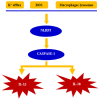The NLRP3 inflammasome and stroke
- PMID: 26131053
- PMCID: PMC4483817
The NLRP3 inflammasome and stroke
Abstract
Inflammasome pattern recognition receptors, which belong to the family of multi-meric proteins, play an important role in innate immunity, including NLRPs, NLRC, and NAIP. Among these receptors, NLRP3 (nucleotide-binding domain (NOD)-like receptor protein 3) inflammasome may activate the inflammation and participate in atherosclerosis, pathophysiology of myocardial infarction, resultin ischemia/reperfusion injury and stroke and other cardiovascular diseases. Effective regulation of NLRP3 may help prevent or even treat stroke. In recent years, the role of inflammation in stroke has attracted much attention, and the in-depth study of its mechanism of action is gradually clear. This mini-review focuses on the association of regulatory mechanisms of NLRP3 inflammasome with the development of stroke, which may supply some clues for future therapies and novel drug targets for stroke.
Keywords: NLRP3; inflammasome; inflammation; stroke.
Figures
References
-
- Donnan GA, Fisher M, Macleod M, Davis SM. Stroke. Lancet. 2008;371:1612–23. - PubMed
-
- Rothwell PM, Algra A, Amarenco P. Medical treatment in acute and long-term secondary prevention after transient ischaemic attack and ischaemic stroke. Lancet. 2011;377:1681–92. - PubMed
-
- Adams HP Jr, del Zoppo G, Alberts MJ, Bhatt DL, Brass L, Furlan A, Grubb RL, Higashida RT, Jauch EC, Kidwell C, Lyden PD, Morgenstern LB, Qureshi AI, Rosenwasser RH, Scott PA, Wijdicks EF American Heart Association/American Stroke Association Stroke Council; American Heart Association/American Stroke Association Clinical Cardiology Council; American Heart Association/American Stroke Association Cardiovascular Radiology and Intervention Council; Atherosclerotic Peripheral Vascular Disease Working Group; Quality of Care Outcomes in Research Interdisciplinary Working Group. Guidelines for the early management of adults with ischemic stroke: a guideline from the american heart association/american stroke association stroke council, clinical cardiology council, cardiovascular radiology and intervention council, and the atherosclerotic peripheral vascular disease and quality of care outcomes in research interdisciplinary working groups: The American Academy of Neurology affirms the value of this guideline as an educational tool for neurologists. Stroke. 2007;38:1655–711. - PubMed
-
- Feigin VL, Forouzanfar MH, Krishnamurthi R, Mensah GA, Connor M, Bennett DA, Moran AE, Sacco RL, Anderson L, Truelsen T, O’Donnell M, Venketasubramanian N, Barker-Collo S, Lawes CM, Wang W, Shinohara Y, Witt E, Ezzati M, Naghavi M, Murray C Global Burden of Diseases, Injuries, and Risk Factors Study 2010 (GBD 2010) and the GBD Stroke Experts Group. Global and regional burden of stroke during 1990-2010: findings from the global burden of disease study 2010. Lancet. 2014;383:245–54. - PMC - PubMed
-
- Global Burden of Metabolic Risk Factors for Chronic Diseases Collaboration (BMI Mediated Effects) Lu Y, Hajifathalian K, Ezzati M, Woodward M, Rimm EB, Danaei G. Metabolic mediators of the effects of body-mass index, overweight, and obesity on coronary heart disease and stroke: a pooled analysis of 97 prospective cohorts with 1.8 million participants. Lancet. 2014;383:970–83. - PMC - PubMed
Publication types
LinkOut - more resources
Full Text Sources


